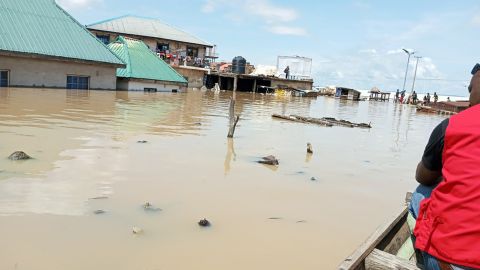The Nigeria Meteorological Agency (NiMet) has said that States in the North-Central and South-Eastern zones of Nigeria should brace up for more flooding.
The director-general of NiMet, Professor Mansur Bako Matazu, stated this on the sideline of the ongoing Hydro-meteorological status and outlook system (HydroSOS) in Abuja on Tuesday.
The director-general while speaking on the current flood impact across the country, said though flooding as a result of rainfall may have reached its peak, flooding as a result of opening of dams and other water holding facilities would still affect States in North-Central and South-East.
He said: “You remember, we issued the forecast in February and we followed up with the monthly updates that we’re going to have above normal rainfall in most part of the country. So in terms of the rainfall induced floods, we have seen the peak but remember we told you that this rainwater gets collected into the reservoirs and dams, and whenever they are filled, it gets filled.
“So presently 13th of September, the lagoon dam was released. Other dams were also released. So what we are witnessing now is riverine flooding. And from the information we are gettiing, we are going to see more flood. And now the rains is concentrating on the North Central and the Southern states. So that will be a combination of short duration, high intensity rain, with riverine flooding. We are going to see more of these floods in the north central states as we have seen in Kogi and also south eastern and southwestern states as we are beginning to see in Anambra and some of parts of Southwest.”
While speaking on the HydroSOS workshop hosted by the Nigerian Meteorological Agency in collaboration with the Nigerian Hydrological Services Agency (NIHSA) with the total support of the United Kingdom Centre 7 for Ecology and Hydrology (UKCEH) and World Meteorological Organisation (WMO), the NiMET director-general said: “it is no longer news to anyone here that water-related hazards and threats has become a global challenge in the face of a changing climate coupled with population growth and increasing socio-economic activities.
“Every year water-related hazard affects millions of people globally and cause damages to properties worth billions of Dollars. It is expected that water-associated risks are going to intensify in the coming years as the full weight of climate change begin to bear on our earth.
“In Africa, water-related hazards such as flood, drought have become a major cause of food insecurity, strains on livelihoods, health risks and conflicts in many parts of the continent.
“Water-related challenges facing governments at all levels include securing water supplies, designing appropriate water governance schematic, sustaining the management of transboundary basins, managing flood and/or drought as well as ensuring the protection and conservation of our ecosystem. It has been observed that one of the major factors to effectively manage water resources and address some of the above challenges is the availability of hydrometeorological information and products targeted to serve the needs of the different sectors.”
Also speaking at the event, the Minister of Aviation, who was represented by the Rector of the Nigeria College of Aviation Technology (NCAT) Zaria, Capt. Abdulsalam Mohammed, said: “this workshop is timely as it intends to address and proffer solutions to global challenges associated with Hydro-meteorological hazards (risks) especially as it relates to Africa and particularly Nigeria.
“Over the years, the management and distribution of water resources as well as mitigation of water-related hazards and disasters has been challenging for government at all levels, globally. Sometimes, this may be attributed to deficiency of hydrometeorological information during planning in times past exacerbated by the impacts of changing climate.
“The deficiency of information can be linked to insufficient local-scale data, a lack of regional to global coherence in hydrological information and modelling systems, limited dialogue between the multitude of actors, which renders the understanding of stakeholders’ water management needs unclear.
“As a result of these shortfalls, water managers and stakeholders cannot properly assess the availability of water resources on different spatio-temporal scales. Thus, the need to have hydrological information and products that are impact-based, demand-driven and users specific.”





